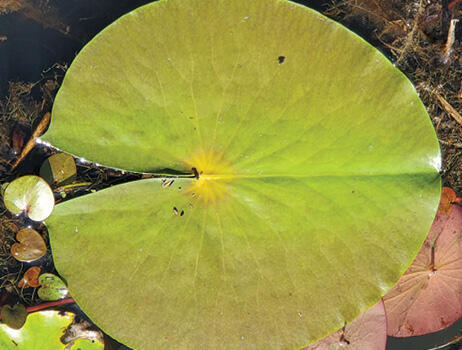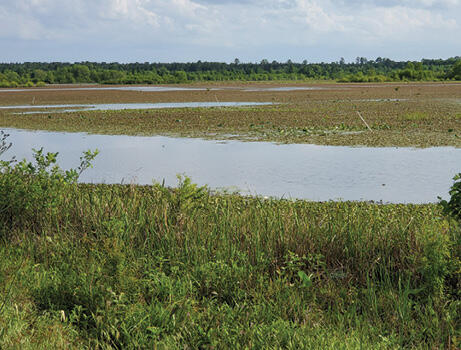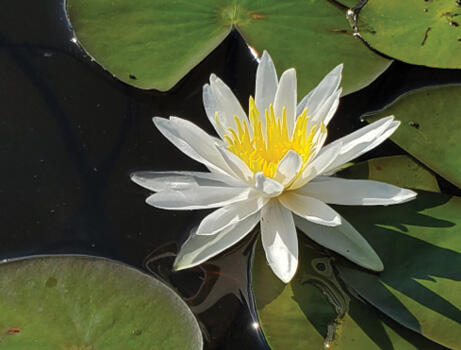P3735-35
Water Lily | Nymphae spp.

water shield leaves.


Water lily is a common calm-water plant that has been extensively added to water gardens and ponds for aesthetics. Some species are native, while others are cultivars or introduced from elsewhere.
The leaves are round to oval and have a deep notch where the leaf stalk inserts. Leaves and stems are spongy, green on the upper surface, and purple or red underneath. The plants grow from rhizomes on the lakebed, with the leaves forming a mat on the surface or emerging just above.
The flowers are very showy. Many are white or yellow, but cultivars and non-natives can be many colors. There are three common types: yellow flowers (N. mexicana), light purple and yellow flowers (N. elegans), and white and yellow flowers (N. odorata).
Management Value
Water lily makes excellent habitat for fish and other aquatic animals in moderate densities. The flowers attract pollinators, and some mammals, turtles, and birds eat parts of the plant.
People have used the rhizomes to make medicine for gastrointestinal issues, sore throats, or dressings for burns. The flowers, seeds, and rhizomes are edible raw or cooked.
Water lily can be used to provide fish habitat and to give ponds a more natural appearance. It can take over shallow lakes, so this plant should be considered for deeper ponds with an understanding that a management plan is necessary. Planting in large containers or on isolated shallow islands is a good approach, with spot treatment of unwanted plants on first appearance.
Recommended Controls
Option 1: 2,4-D (3.8-pound formulation). 2,4-D should be applied as a submersed injection (1.75 gallons per acre-foot of water). Determine pond volume prior to application. Do not exceed annual herbicide rate limits as stated on the product label.
Option 2: Endothall (4.23-pound formulation). Endothall should be applied as a submersed injection (1.3 gallons per acre-feet of water). Determine pond volume prior to application. Do not exceed annual herbicide rate limits as stated on the product label.
NOTE: Acre-feet = average depth of pond multiplied by pond acreage; average depth is calculated by taking the depth at 20 points across a water body and averaging the values.
Submersed injection means that the herbicide solution is applied below the water surface directly into the water. For larger water bodies, treat one-third of the water body at a time and wait 2 weeks between applications. Then, treat the next one-third of the water body.
The best approach is to treat ponds with herbicides when water temperature is at least 60˚F and the plants are actively growing. Multiple applications may be necessary to achieve eradication.
Read and follow all chemical label instructions, especially the section on the use of personal protection equipment.
Photo Credits Bottom: Samantha Bergeron, MDWFP

The information given here is for educational purposes only. References to commercial products, trade names, or suppliers are made with the understanding that no endorsement is implied and that no discrimination against other products or suppliers is intended.
Publication 3735-35 (POD-11-23)
By Wes Neal, PhD, Extension/Research Professor, Wildlife, Fisheries, and Aquaculture; Dennis Riecke, Fisheries Coordinator, Mississippi Department of Wildlife, Fisheries, and Parks; and Gray Turnage, PhD, Assistant Research/Extension Professor, GeoSystems Research Institute.
The Mississippi State University Extension Service is working to ensure all web content is accessible to all users. If you need assistance accessing any of our content, please email the webteam or call 662-325-2262.
